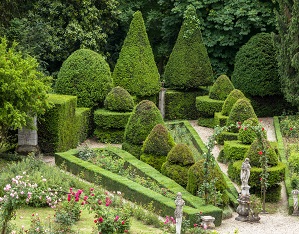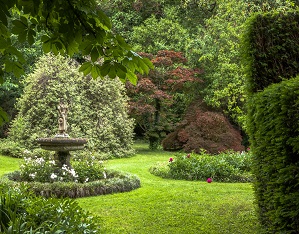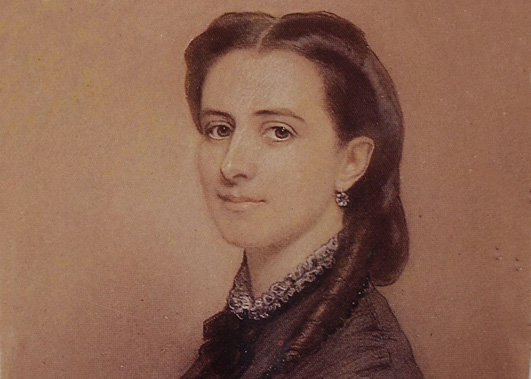A highly cultivated, vital and joyous historic garden established in the 1880s commissioned by Countess Evelyn van Millingen Pisani, with roses growing profusely in the parterres, playful boxwood patterns, and lawns covered with flowers growing amongst the trees across the vast landscape park. .
For centuries the vast Vescovana estate, with a building probably dating to the 17th century, represented a precious source of income for the prestigious Pisani family, owners of the grand villa of the same name in Stra which had already fallen into disuse due to the downfall of the Republic of Venice. The fate of the estate was improved by Almorò III Pisani’s wife, Evelyn van Millingen, a cultured and refined woman, who starting in 1880, provided the house with terraces on the main floor and completely reorganised the garden. In the area near the villa, the countess created a vast fan-shaped formal garden with elaborate parterres, bordered by thick, low boxwood hedges with flowers at the centre, embellished with a lavish sculptural decor with herms, balustrades, obelisks and a cup-shaped fountain. Among the original flowers chosen by Evelyn there were various species of tulips, hyacinths, narcissi, crocuses, irises, lilies, gladioli, following the guidelines of Hortus Floridus (1614) by the Dutch Crispijn van de Passe who had contributed to the spreading of the “tulip mania” across Europe. The marked axial structure of today’s garden gradually blends into the natural layout of the surrounding park, home to many centuries-old trees, a rock garden, a theatre, a temple, folly ruins, an ice-house and the 1860 family chapel, an important example of Elizabethan Gothic Revival by architect Pietro Selvatico Estense.
Highlights

The view from the main hall
The best views of the garden are enjoyed from an elevated position to be able to take in the whole structure centred on the vast regular fan-shaped layout, so unusual for in Veneto, resonating with the Victorian trend of the period and with the passion for botany of Countess Evelina who was born in Constantinople to an English father and a French mother.

Flowers and colours
Inspired by Evelyn’s garden layout, current owner Mariella Bolognesi Scalabrin has reintroduced to the park’s vast lawn thousands of bulbs of all species and colours. The April flowering is indeed a wonderful sight, not a far cry from the finest Impressionist paintings.

The coexistence of two styles
A visit to Villa Pisani Bolognesi Scalabrin allows the observation of two styles that followed one another in the history of gardening. By the villa, greenery is used to create a formal layout eventually transitioning into a landscape area with the typical presence of large trees growing according to their natural patterns.
Find out more
GREAT WOMEN, GREAT GARDENS
The daughter of an English father and of a French mother, Countess Evelina enjoyed a cosmopolitan upbringing. In 1853 she married Count Almorò III Pisani, the last descendant of the family that had commissioned the villa at Stra.

 Villa Pisani Bolognesi Scalabrin
Contacts
Villa Pisani Bolognesi Scalabrin
Contacts
Contacts
Telephone:- +39 0425 1547191
- +39 366 496470
Fax: 0425 920016
Address
Via Roma, 31
35040, Vescovana (PD)
 Villa Pisani Bolognesi Scalabrin
Opening times and prices
Villa Pisani Bolognesi Scalabrin
Opening times and prices
Opening hours
- from 9:30 to 12:30 and from 14:00 to 18:00 (last entry at 17:00).
Pricing
- Single adult: € 8,00
- Over 70 years: € 6,00
- Children from 6 to 12 years: € 5,00
- Free admission for children under 6, disabled people, teachers, accompanying persons
- Family of 4 people: € 20,00
- Touring Club, FAI, ADSI, Camper Life members, subscribers presenting the “CartaVerde”: € 6,00
- Students: € 4,50
Guided tour
- Supplement of € 25,00 for guided tour in Italian. If in original language the cost of the licensed guide is to be agreed.
 Villa Pisani Bolognesi Scalabrin
How to get there
Villa Pisani Bolognesi Scalabrin
How to get there
Address
Via Roma, 31
35040, Vescovana (PD)
Latitude: 45.1355662
Longitude: 11.7060407
How to arrive by road
Motorway A13 – Venice – Padua – Bologna, exit at Boara Pisani. At the Boara exit, turn left onto the state road in the direction of Padua, and drive for about 3 km until the traffic lights in Stanghella. Turn left again, following the signs for Vescovana, and continue for 3 km until you reach the stop sign. From here go down to the left along the tree-lined square. To enter the Villa, ring the gate with intercom on Via Roma, 19 (in front of the Town Hall). Vescovana is 30 minutes from Padua, 45 minutes from Venice or Bologna, 20 minutes from Ferrara.
How to arrive by train
Railway line Venice – Padua – Bologna. You can get off at Monselice or Rovigo station and then take a taxi.
 Villa Pisani Bolognesi Scalabrin
Services/Accessibility
Villa Pisani Bolognesi Scalabrin
Services/Accessibility
Services
Villa Pisani offers the possibility to stay in a historical residence and to be hosted in spacious frescoed rooms, overlooking the garden and furnished with period furniture. For further information please consult the website.
Dogs are welcome but only on a leash and with companions equipped with the appropriate bags.
On Saturdays and Sundays the Villa offers the possibility to organize picnics in the garden. Visitors should gear up with plaid and food brought from home. Reservation is recommended.
Educational paths and workshops
- It is possible to book guided tours and workshops for children and schools. For more information about types and costs consult the website.
Accessibility
The areas accessible to visitors with limited mobility are the ground floor, the garden, the park and the barchesse.
 Villa Pisani Bolognesi Scalabrin
Private events
Villa Pisani Bolognesi Scalabrin
Private events
At Villa Pisani Bolognesi Scalabrin you can organize many private events such as weddings, parties, meetings, conferences and photo shootings.
 Villa Pisani Bolognesi Scalabrin
Itineraries
Villa Pisani Bolognesi Scalabrin
Itineraries
You could find the garden in these itineraries
 Favorite saving result
Favorite saving result
 Warning!
Warning!
You've have to sign up or sign in to add this element to your favorites.
